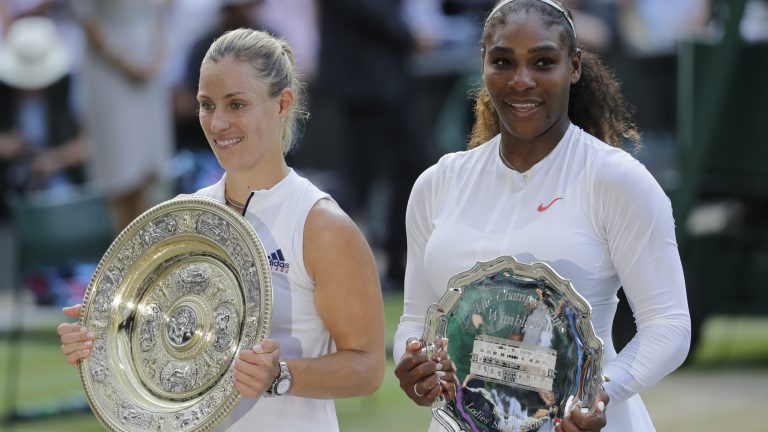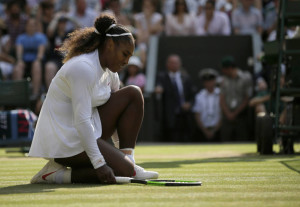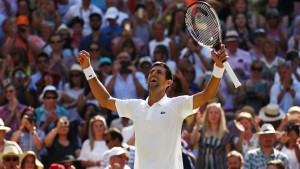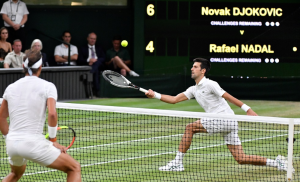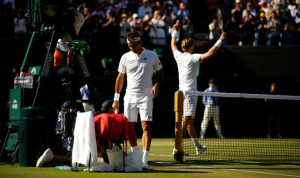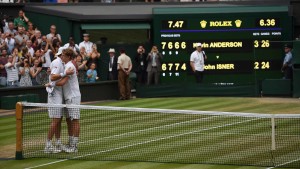Angelique Kerber defeats Serena Williams 6-3, 6-3 to Win First Career Wimbledon
The women’s draw was marked by a historical number of upsets as all of the top 10 seeds were knocked out before the Quarterfinals. It paved the way for the Return of the Queen to another Major Final and a chance to tie Margaret Court’s record of 24 Grand Slam titles. It was a relatively easy path for Serena Williams to get to the Wimbledon Final. However, she faced a difficult test in the Final in Angelique Kerber. She is a great defender who redirects the ball very well and can force Serena to move around the court. Moreover, Kerber had already defeated Serena in a Major, the 2016 Australian Open, and faced but lost to Serena in the Wimbledon Final 2 years ago in 2016. Although Serena has blown way past any realm of reasonable expectations, it was also probably too much to ask for her to win a Grand Slam title in only her fourth tournament back after giving birth. It would have another fairy tale chapter in her storied career if she marked her return with a championship at Wimbledon. Nevertheless, a Final appearance is still a great story and puts the tennis world on notice that the Queen is back and will contend for more Grand Slams.
Kerber played a flawless match from the start. She opted to receive first so she could steal an immediate break of Serena’s serve before her opponent could settle down and get a feel for the match. Kerber got that break and kept Serena chasing from behind all match. She gave very few opportunities for Serena to get into the match. At 2-1 in the first set, Serena broke at love to level the set and started to find lines with her shots. It looked like she was about to get going. However, it was just the first of multiple false alarms when it appeared Serena could get going and make a comeback. For the rest of that set and the match, Serena just made too many unforced errors, especially hitting the ball long. She was also not moving well, which was a major problem against Kerber who is an exceptional defender and great at making her opponents move all over the court. Moreover, Serena never got her legendary serve going to bail her out. At 3-3, Serena had an uncanny, back to back double faults to set up triple break point. She saved two break points before ultimately getting broken. More unforced errors piled up. Serena lost that first set 6-3 and quickly fell down a set.
Early in the second set, there were a couple more false alarms when it looked like Serena would begin to impose her power and will. Down 1-0, the return of her patented scream occurred when she cut off a Kerber cross court shot at the net as Serena went on to hold serve. Up 15-0 at 1-1, Kerber rushed the net and Serena smashed a laser right past her chest. Although that shot went long, you could see Serena finding her intensity. She was getting more and more pumped as that game progressed and shouted her demonstrative “Come on” which usually foreshadows a turning of the tide during her matches in her favor. Nevertheless, the steady Kerber held her serve and weathered that quick storm. Kerber would get her break to go up 4-2 in the set. The crowd kept waiting for Serena to put it all together and find herself in the match but time was quickly running out as unforced errors squandered any openings Kerber gave her. At 5-3 with Kerber serving for the match, Kerber was up 15-0 and Serena missed an easy overhand smash that basically sealed the match. It symbolized the frustration of the day for Serena as she dropped to her knees out of disbelief at her poor play. Nevertheless, she fought in that final game. She pulled off a gutsy drop shot down 30-0 and leveled the game at 30-30. However, Kerber hit a brilliant forehand that narrowly clipped the back line to set up match point then converted to capture the coveted Wimbledon title.
With the victory, Kerber now has three Grand Slam titles. Her first Wimbledon title adds to her 2016 Australian Open and 2016 US Open. In addition, she is only the second player to defeat Serena in two Grand Slam Finals. The other player is Serena’s sister, Venus. Kerber is a late bloomer but has now carved out a great career. Moreover, she has the game to win more Grand Slams to add to her count. For Serena, it is a major step forward in her comeback after giving birth. It is difficult to tell exactly where she is in returning to her top form before she left the game. She made it to the Final but the path cleared perfectly for her. She also got annihilated in the Final by Kerber. Was the loss the product of nerves from being back to her first Grand Slam final since her hiatus? She definitely wanted to win badly. It would have been very special sharing it with her daughter. Even the great Serena is ultimately human. Sluggish movement is a symptom of nervousness and she certainly showed lots of symptoms during the Final. Were pundits overstating how well she was playing with the weak field she ended up beating to the Final? Time will tell as we watch her the rest of the season. Nonetheless, it is definitely significant progress. She has already shown enough to alert the rest of the sport that she has returned and will be a force to be reckoned with again.
Novak Djokovic Defeats Kevin Anderson to Capture Fourth Wimbledon and 13th Career Grand Slam
The real Men’s Final was the Semi-Final epic battle between Djokovic and Rafael Nadal (discussed below). Kevin Anderson played great in the tournament to get to the Final. It included the match of his career when he stormed back from down 2 sets to 0 to stun the defending Champion, Roger Federer. Anderson is tall, powerful server. His serving was immaculate against Federer after the first set of their Quarterfinal. Nevertheless, his game does not fare well against Djokovic, arguably the greatest returner of all-time. Anderson cannot simply overpower and blast balls in short rallies against Djokovic. Djokovic will get to balls most players do not and make his opponent hit extra shots. Moreover, Anderson had been on the court for more than 21 hours heading into the Final. It included 2 straight five setters and the 6 ½ hour marathon against John Isner that ended 26-24 in the fifth set. Even at full strength, Anderson would have a big uphill climb against Djokovic. Compromised by fatigue, he had little chance in the final. In the first two sets, Djokovic dictated play immediately from the start with a break in the first game. In addition, he really did not have to do too much to push the slow moving Anderson around. On returns of Anderson’s serve, Djokovic simply hit it right back up the middle at his opponent and Anderson had trouble moving his feet a little to put a good hit on the ball. In the rallies during the match, Anderson made no attempts to move in. Accordingly, Djokovic just hit it back and moved Anderson around until he hit mishit (e.g. long, into the net, etc.). I do give a lot of credit to Anderson for fighting back and making the third set competitive. Anderson held his serve the entire set and battled into 5 break and set points late in the set. Nonetheless, he delayed the inevitable. Djokovic saved all set points and cruised to victory in the third set tie breaker. Immediately after the match, Djokovic let out a sigh of relief and took a moment to collect himself before rejoicing in his great achievement.
With the Wimbledon title, Djokovic emphatically stamped his return to the top of the sport and a contender going forward. Federer and Nadal rotated winning the last 6 Grand Slams. It is only fitting that Djokovic reentered the mix. It is also great for the sport for their three biggest stars to be back at the top, especially since no heir apparent has yet emerged to capture our attention and imagination the way the three headed monster has. There were many reasons for the lull in his career. The first was family issues that I cannot speak to and will not comment on. In terms of the factors I will remark on, the biggest component was probably motivation. After winning the 2016 French Open, he completed the career Grand Slam. He had dominated the sport from 2011-2016. It is extremely difficult to maintain championship habits and focus. As Djokovic rose to prominence, he also had the greatness of Federer and Nadal to push him. He utilized the slight of living in their shadows as motivation. As we know, Federer and Nadal were both absent from the sport by the end of the 2016 Wimbledon. With their injuries, it was a fair question whether they would only return as shells of themselves in the twilight of their careers. Their absence could have contributed to the lack of motivation for Djokovic. He could chase their records but the competitive spirit of facing those players on the court cannot be replicated by numbers. Another factor is age. The end of a tennis player’s prime is around 28 to 29 years old. Although they can adapt their game and adjust with smarter play like Federer and Nadal have, they will lose something in terms of pure athleticism and/ or mental focus. At 31, Djokovic is certainly not as great as he was 3-5 years ago. Nevertheless, he has just shown he has plenty left in the tank to win more Grand Slams. Like Federer and Nadal, he is in position for great success past his peak prime.
Novak Djokovic defeats Rafael Nadal 6-4, 3-6, 7-6 (11-9), 3-6, 10-8
In the end, the de facto Men’s Final was the Semi-Final between Novak Djokovic and Rafael Nadal. Heading into the tournament, the dream Wimbledon match would have been another Roger Federer and Rafael Nadal Final, ten years after they played the greatest tennis match of all time in the 2008 Men’s Wimbledon Final when Nadal prevailed in an epic 5 setter. Instead, we settled for an instant classic in the Semi-Finals between another legendary rivalry: Nadal and Djokovic. Without a doubt, it was the marquee matchup of the 2018 Wimbledon. It played out into a 5 hour match spanning two days [a consequence of the John Isner and Kevin Anderson Semi-Final ran 6 ½ hours and ended with Anderson winning 26-24 in the fifth set]. While Federer and Nadal is the most revered matchup in the sport, Nadal and Djokovic have actually played each other significantly more times: 52 vs the 38 matches between Federer and Nadal. Moreover, the matchup has basically been dead even with Djokovic holding a slight 26-25 edge heading into the match. Accordingly, it was expected that the Semi-Finals would be another grinder. It played out that way. It ended up as a coin flip game where either player could have easily won.
The players split the first two sets with Djokovic winning the first and Nadal responding by winning the second. The match intensified in the 3rd set with an unbelievable tiebreaker. It featured multiple brilliant and timely drop shots from both players. Nadal utilized his legendary forehand that resulted in a lopsided number of forehand winners in his favor. Nevertheless, Djokovic is the greatest returner of all-time and his brilliant defense helped him stay with Nadal. Both players had multiple set points in that tiebreaker. Nadal had 3 and Djokovic had 2. Near the end of the tie breaker, Nadal went for one too many drop shots. Djokovic anticipated it and smashed it for a cross court winner on route to winning the tie breaker and third set 7-6 (11-9). Due to the length of the first semi-final matchup between Anderson and Isner, the second semi-final hit the curfew time of 11 PM and was suspended till Saturday morning.
When played resumed, Djokovic was up 2 sets to 1 and made a smart, calculated gamble to force the issue and be aggressive from the start of the first game in the fourth set. He got two break points immediately but Nadal saved both of them. It was a foreshadowing of the rest of the match. Djokovic had many break points on Nadal’s serve but converted very few of them. If Djokovic ended up losing the match, he would have regretted the plethora of break points he let slip through his fingers. Nadal would break Djokovic in the second game of the set to go up 2-0. Djokovic broke back easily to get it to 3-2. However, he would be broken by Nadal again when he smashed an easy shot into the net to give Nadal a 5-3 lead in the set. At that point, Djokovic slammed his racket multiple times against his foot out of frustration. As we have seen in the past, Djokovic can have a temper. He is able to channel it as motivation most of the time. Nevertheless, he is combustible so you wait to see if he self-destructs. In the next game, Nadal double faulted to set up triple break point for Djokovic. However, Nadal saved all three break points. Eventually, he hit an ace that was initially called out. He challenged it to confirm it was in and send the match to a deciding fifth set. The triple break points was another golden opportunity squandered by Djokovic. With his temperamental personality surfacing, I began to question how many more missed opportunities he could endure before he relented and lost out of frustration. To his credit, he did not submit and allow his own emotions to beat him.
The beginning of the fifth set began casually with holds of serve and no break points. Djokovic got the first break point opportunity up 4-3 but again squandered it. It was the calm before the storm as the final set would get very exciting. At 4-4, Djokovic was in serious danger of losing the match with unforced errors that set up a double break point opportunity for Nadal late in the set. However, Djokovic saved both break points with two big time serves. The first was an ace and the second locked Nadal up. Later in that game, Nadal just missed curving a forehand back inside the baseline that would have set up another break point. Eventually, Djokovic held serve to go up 5-4. At 7-6, Djokovic was up 30-15 and two points from winning the match. However, he got extremely frustrated by his mishits. It was clear he was starting to lose his composure and wasting energy on venting. Nadal held serve to level it at 7-7. In the following game, Djokovic was in peril of losing the match again. He fell behind 15-40 and appeared to lose his focus by dwelling on his many missed opportunities that were starting to pile up. Nonetheless, he was able to regain his composure again and dig deep. He saved both break points again. Moreover, Nadal set up a third break point on an amazing forehand winner that was called out but challenged and confirmed to be in. Nevertheless, Djokovic staved off the break with an incredible rally that ended with a laser forehand winner that whizzed past Nadal who was moving forward to the net in an attempt to cut it off there. That game was an epic hold that featured 5 deuces. In the next game with Djokovic up 8-7, Nadal had two unforced errors. The first shot was hit into the net and the second was a backhand that went wide of the baseline with a wide open court that should have produced an easy winner. It set up match point but Nadal saved it with a great drop shot. He would level the set at 8-8. To that point, the players had made incredible shots to save break points and a match point. Every point was nerve racking. Ironically, the end was a little bit anti-climactic. With Djokovic up 9-8, Nadal casually fell in a 40-0 hole to set up triple match point. Djokovic would finally convert to win the marathon Semi-Final match.
For Nadal, he played brilliantly and just lost to another all-time great and his equal. Nonetheless, it is a missed opportunity in his race against Roger Federer for the title of greatest tennis player of all-time. If he squeaked out a win against Djokovic in the Semi-finals, he would have likely beaten Kevin Anderson who he easily dispatched in straight sets at last year’s US Open. In addition to closing the Grand Slam title gap with Federer from 20-18, Nadal would have added a third Wimbledon and diversified his total more from the current 65% at Roland Garros (11 French Opens in his 17 total). As critics analyze Nadal’s claim for the GOAT, a fair point is that a lopsided number of his titles are at the French Open where he is virtually unbeatable. A third Wimbledon Championship on grass would have been huge in negating that potential knock. Nevertheless, Nadal has found a second wind in his career and shows no signs of slowing down. He should have more chances to add to his Grand Slam count. The race for GOAT is far from over. Nadal likely has more time left in his career than Federer. At the age of 32, Federer also had 17 titles. Obviously, the next three took a while for Federer and far from a given. An advantage Nadal has at the same advanced age (32+) is that his main rivals (e.g. Federer, Djokovic, and Andy Murray) are also over 30. While Federer played extremely well between 32-35 years of age, Djokovic was in the middle of his prime and Nadal was in the back of his prime. Federer, Nadal, and Djokovic are all playing great at the same time again but they will certainly never recapture their peak at their current ages. Consequently, Nadal will have a little easier time racking up more Grand Slams late in his career than Federer had. Of course, Nadal still seems unbeatable at the French Open. He may get an additional three just from Roland Garros. Nonetheless, winning is still extremely difficult and he still needs to go out and do so.
Kevin Anderson defeats Roger Federer 2-6, 6-7 (7-5), 7-5, 6-4, 13-11
In a tournament with a historical number of upsets in the Women’s Draw, the upset of the tournament was Roger Federer falling in five sets to Kevin Anderson. It is especially shocking when you consider Federer was up 2 sets to 0 and had a match point in the third set. Of course, Federer is way past his prime despite his brilliance late in his career. 10 years ago, Federer would have never coughed up a 2 set lead to anyone. Nevertheless, Anderson’s comeback is probably the greatest ever in the history of Wimbledon because it was 2 sets down against arguably the greatest player ever on his best surface where he has also won the most Wimbledon titles ever. At first glance, it seems unthinkable. If you look closer, it makes more sense. After the dominating and easy first set, Federer was having trouble with the powerful serve and service game of the very tall Anderson. He simply could not break the serve after the first set: only once in the second set and no more afterwards. He narrowly won the second set on a tie break. Federer had match point in the third set but it was not like he was serving for the match. In hindsight, it was an anomaly that he had match point because he had very little opportunities to break and could not take advantage of them in the last three sets. With a serve as powerful as Anderson’s, a player needs to do a lot of educated guessing. Once Federer lost a feel for it and could not read it, he was basically swinging blind out there. Nevertheless, Anderson gets a lot of credit for his perseverance, belief, and dominating serving. He definitely won the match more than Federer lost it. Although Federer was average for his standards, it is difficult to say he choked when he was only broken once in each of the last three sets and the final set was 13-11.
Of course, each loss deep in a Grand Slam hurts for Federer more than it did when he was younger. He was the favorite to win the tournament entering the fortnight. He had a relatively easy path to the Final and looked like he would cruise to it. At his advanced age, he wants to add to his Grand Slam count as much as possible before his career is over especially with Nadal keeping pace. The loss in the Quarterfinals reminds us how special his last three Grand Slam titles over the last two years have been at the back end of his career. Nonetheless, it could just be a bad loss against a player who got hot. At some point, Father Time will win and Federer’s game will fall off a cliff. Nevertheless, he has defied age for so long that there is no reason to believe he will not have more deep runs and chances to win more Majors.
The Fifth Set Tiebreaker Issue: Kevin Anderson defeats John Isner 7-6 (8-6), 6-7 (5-7), 6-7 (9-11), 6-4, 26-24
After the 6 ½ hour marathon Semi-Final between Anderson and Isner concluded with 50 games in the fifth set, there is clamoring for the first three Grand Slams of the year (Australian Open, French Open, and Wimbledon) to change to a fifth set tie breaker like the US Open. The Anderson/ Isner match might be the tipping point that changes the rule. In my opinion, it is an aberration. It can only happen between two dominant servers who are average returners. Isner is notorious for playing in a lot of tiebreakers because his serve is extremely difficult to break but he has trouble moving at his size to break back. Moreover, Isner also played in the longest match ever. In a match against Nicolas Mahut in the first round of the 2010 Wimbledon, the two men entered into a five set struggle that lasted 11 hours over 3 days and ended with Isner winning 70-68. There were no cries for change in 2010 because their first round match did not delay a Nadal/ Djokovic Semi-Final and a Women’s Final featuring Serena Williams. Usually, two tall dominant servers like Anderson and Isner do not meet so deep into a tournament. They are dangerous in individual matches but two such players rarely string together 5-6 matches in the same tournament to meet deep in a Grand Slam because they play so much just to win each match. If Federer [on a good day], Nadal, or Djokovic were in the Semi-Final to return against either man, Isner or Anderson might have won but it certainly would not have lasted 50 games in the fifth set.
To add to the last point, critics are clamoring because it was a marathon match against Kevin Anderson and John Isner. If the Federer/ Nadal final in 2008 went 50 games, everyone would have adored it. If either legend played 50 games against Anderson or Isner, I believe the viewing public would have tolerated it. Obviously, Anderson and Isner have no blockbuster appeal. Moreover, it is rough to watch dominant serving and infinite quick points with few captivating rallies. I do not feel it is necessary to change rules because of an anomaly. Moreover, I do not like the idea of deciding a Grand Slam in the fifth set with a tie break. It is not a good representation of the overall play that it takes to get to 6-6 in the fifth set. It is similar to how penalty kicks are not a perfect decider of which team is better in a soccer match. If a fifth set tie breaker was in place in the past at Wimbledon, the 2008 Men’s Final and the greatest match ever would have been decided in a tie breaker instead of a riveting 9-7 fifth set won by Nadal. The 2009 Wimbledon between Roger Federer and Andy Roddick would have also been decided by a tiebreaker instead of the 16-14 epic conclusion. A lack of a tiebreaker was not an issue after those matches. It is only an issue now because Anderson and Isner were boring with their style of play and they were not brand names locked in combat. Again, it is just not necessary to change a rule because of a fluke occurrence.
I support the idea of needing to break your opponent’s serve if you are going to win a Grand Slam title in a fifth set. On the other hand, I understand the argument that a marathon match will compromise a player for his next match. If change occurs, I hope that they only make a change for matches before the Final. I suggest going to a fifth set tie breaker after 10-10 in the fifth until the Final. For the Final, it should revert back to unlimited games until a champion wins by two games.
About Pat Wong
Patrick is a contributor for Rookerville. He is an avid sports fan. Before joining Rookerville, he was part of a defunct New York Yankees message board, NYYankeefans, where he was its top poster and was inducted in its Hall of Fame for his contributions. Patrick is also a passionate fan of movies. He has enjoyed reading movie reviews over the years and is excited about the opportunity to review movies. Patrick is also a passionate foodie. He is Yelp Elite for three years in a row and shares his great finds in New York and his travels.

